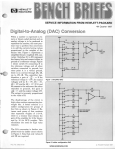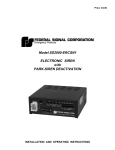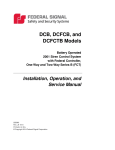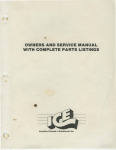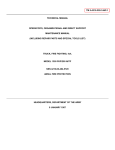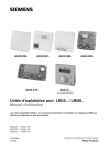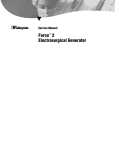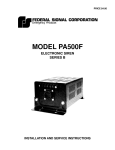Download model pa500m* amplifier
Transcript
PRICE $2.00 MODEL PA500M* AMPLIFIER SERVICE MANUAL SECTION I GENERAL DESCRIPTION The standard operating functions of this siren are Wail, Tap II, Yelp and manual peak-and-hold. The Tap II feature allows the driver to change the siren sound from wail to yelp via the vehicle’s horn ring. Tap II provides an especially effective traffic clearing capability. The siren also has provisions for public address (PA) operation. An optional Federal Model MNCT Microphone is required if it is desired to make use of the PA capability. Its splashproof enclosure complies with SAE specification J1211 for splashproof testing. Available shock and vibration mounting hardware make it an ideal choice for a motorcycle siren. Installation instructions are contained in a separate document included with this siren. Figure 1. Model PA500 Amplifier. The Federal Model PA500M* Amplifier is a precision built, reliable electronic siren incorporating state-of-the-art CMOS technology. The siren operates from a nominal 12Vdc, negative ground, electrical system. It is capable of operating with one 58watt speaker or one 100-watt speaker. (Model PA500M* comes factory set for a 58-watt output.) The factory set output can be changed, as described in Section IV of this manual. The siren’s power/control cable is terminated with bullet connectors. These connectors mate with connectors from the control head, power source and speaker to provide a quick, easy installation. Also, the unit’s slide-in/out design facilitates servicing. -1- SECTION II SPECIFICATIONS Input Voltage . . . . . . . . . . 11Vdc to 16Vdc Polarity . . . . . . . . . Negative ground only . . . . . . . . . 30mA ± 5mA Operating Temperature Range . . . . . . -30°C to +65°C Operating Current (14Vdc, Wail) . . . . . 4.5 amperes (58 watt) 7.0 amperes (100 watt) Frequency Range . . . . . . . . . 500 to 1500Hz Cycle Rate . . . . . . . . Wail - 12 cycles/minute (nominal) Yelp - 180 cycles/minute (nominal) Voltage Output (approx.) . . . . . . . 45V p-p (58 watt) 60V p-p (100 watt) Audio Frequency Range . . . . . . . 300 to 10KHz Harmonic Audio Distortion (300-3KHz) . . . 10% max. all power levels from 1/2 to 50 watts Input Voltage Required to Obtain 15Vrms across Speaker Load . . . . 0.5Vrms Dimensions (HWD - less mtg. brkt.) . . . . 3.05" x 4.36" x 6.38" Net Weight . Standby Current . . . . . . . . . . . . 4-1/2 pounds Shipping Weight . . . . . . . . . 6-1/2 pounds -2- SECTION III CIRCUIT DESCRIPTION neously, control pin IC5C-pin 6 goes to a logic “1” and allows the siren to charge at a yelp rate until the tone peaks. Refer to the block diagram (figure 2) and schematic diagram (figure 3) while reading this section. 3-1.RATE OSCILLATOR AND VOLTAGE CONTROLLED OSCILLATOR. IC1, a phase-locked loop, contains the voltage controlled oscillator. C8, R1, R5, R13 and the control voltage on IC1-pin 9 determines the output frequency. As the siren coasts down in the manual mode, the output of the VCO must be disabled to prevent frequencies lower than 350Hz from damaging the amplifier’s output transistors. IC2, a voltage comparator, compares the VCO control voltage to the low frequency reference voltage set by R15 and R23. When the VCO control voltage drops below the reference, IC2-pin 7 goes to a logic “1” through OR gate IC4B. The VCO is also inhibited when the microphone push-to-talk input is selected. This logic level is gated through IC8D and IC4B to the VCO inhibit pin. The rate oscillator and voltage controlled oscillator (VCO) sections are the “heart” of the Model PA500 circuitry. Not only does the rate oscillator determine the cycling rate of each siren tone, but it also generates the control voltage that operates the VCO. The VCO generates a square-wave output whose frequency is directly proportional to the control voltage. The output of the VCO is coupled to the siren preamplifier. The siren rate oscillator consists of an LM555 timer configured as an astable oscillator. The astable oscillator (IC3) employs an analog switch (IC5C) to select the RC timing network which determines the astable oscillator’s timing rate. IC5B, another analog switch, connects the discharge pin of IC3 to the RC timing network. When the peak function is called for, the control pin IC5-pin 5 goes to a logic “0” putting the switch in a high impedance state (OFF). Simulta- 3-2.SIREN MODE CONTROL. The wail mode is controlled by a logic “0” at IC8A. Through IC8A, the astable oscillator is enabled and the wail function is produced. While the wail mode is activated, the yelp mode may be selected by a logic “0” at IC8C. Through IC7 and IC8, flip-flop IC6 changes state and brings control pin IC5-pin 6 to a logic “1” thus switching in the necessary RC network to produce the yelp signal. The manual mode is enabled with the siren in the standby mode and IC8C-pin 11 at a logic “0”. IC4C, IC5B, IC5C and IC7B provide the necessary decoding for the manual mode. 3-3.AUDIO SECTION. The amplifier system consists of MOSFET/ Bipolar complementary voltage and power gain amplifiers. The circuit consisting of Q5, Q6, Q7 and Q8 use both AC and DC feedback to insure stability and maximum linear signal swing. The overall midband voltage gain is set by the ratio of feedback resistor R43 and Q5 source resistor R16. Frequency compensation is set by the combination of C3,R28 and C27. Figure 2. Block Diagram. -3- Audio signal levels are coupled to the amplifier through R41. An input voltage of approximately 250mV is required to drive the amplifier to full rated sine wave power. This level is produced by the transistorized MNCT* microphone in the PA mode. thermistor RT1 and the voltage divider (R1 and R12) across diode reference CR2. Q1 is used to switch the bias “on” during PA messages. 3-4. POWER SECTION. The amplifier enable line uses a relay (K1) to disable the amplifier section, when neither siren or PA functions are needed. The ignition line supplies B+ to the printed circuit board. Networks consisting of C18, CR6, CR7 and C17 provide input filtering for voltage regulator LM7808. B+ from the battery supplies bias to the output section consisting of T201, Q201 and Q202. Temperature compensation and bias current for minimizing crossover distortion is supplied by SECTION IV SERVICE AND MAINTENANCE Carefully check all envelopes, shipping labels and tags before removing or destroying them. SAFETY MESSAGE TO PERSONNEL SERVICING FEDERAL SIGNAL ELECTRONIC SIRENS The lives of people depend on your safe servicing of Federal products. It is important to follow all instructions shipped with the products. In addition, listed below are some other safety instructions and precautions you should follow: 4-2. GENERAL. Most of the electronic component parts used in the PA500M* are standard items that are available at almost any radio or electronics supply outlet. • Read and understand all instructions in this manual before servicing this equipment. The factory can and will service your equipment or provide technical assistance with problems that cannot be handled satisfactorily and promptly locally. • To properly service an electronic siren, you must have a good understanding of automotive electrical systems and emergency signalling procedures. • All effective sirens and horns produce loud sounds which may cause, in certain situations, permanent hearing loss. You should take appropriate safety precautions such as wearing hearing protection. If any unit is returned for adjustment or repair, it can be accepted only if we are notified by mail or telephone in advance of its arrival. Such notice should clearly indicate the service requested and give all pertinent information regarding the nature of the malfunction and, if possible, its cause. • Address all communications and shipments to: Service Department Federal Signal Corporation Signal Division 2645 Federal Signal Drive University Park, IL 60466 In order for the electronic siren to function properly, the ground connection must be made to a solid chassis component and not to an insulated point. 1-800-433-9132 When replacing small components, use care when soldering. Heat easily damages integrated circuits, transistors, capacitors and circuit boards. Therefore, it is advisable to use a heat sink on the component lead being soldered. Failure to follow all safety precautions and instructions may result in property damage, serious injury, or death to you or others. 4-1. UNPACKING. 4-3. MODIFICATIONS. After unpacking the siren, examine it for damage that may have occurred in transit. If the equipment has been damaged, file a claim immediately with the carrier stating the extent of the damage. The following paragraphs describe modifications which can easily be made to the Model PA500M* by a qualified service technician. Before any of the -4- 3. Install jumper wire (JU1) at position labeled SLOW PEAK. modifications can be attempted, the front cover must be removed. The screws which secure the front cover to the housing should be removed with a 1/4-inch wrench or flat blade screwdriver. Slide the chassis out of the housing. A. 4. Install a 100-ohm, 1/4watt, resistor at position labeled CUTOFF. 5. Reinstall the PC board with the four screws removed in step 1. Install J1, J2 and J3. Insure that the polarization of the connectors is correct. Output Power Modification. NOTE The Model PA500M* comes factory set for a 58-watt output. Locate the 12-position terminal strip on the output PC board (see figure 5). Using a flat blade screwdriver, move the orange wire to the described position. 4-4. PA GAIN ADJUSTMENT. The Model PA500M* comes from the factory with the PA gain set to maximum. To decrease the gain setting, proceed as follows (see figure 4): TB201, pin 1 for 58-watt output. TB201, pin 2 for 100-watt output. B. A. Remove the four screws which secure the front cover to the housing. Slide the chassis out of the housing. Coast Down Elimination. B. The Model PA500M* comes from the factory wired so that it will coast down after a siren function has been deactivated. To eliminate the coast down feature, and have the siren sound come to an abrupt stop when the siren function is deactivated, proceed as follows (see figure 4): C. Using a small flatblade screwdriver, rotate R41 counterclockwise to a desired volume setting. D. Reinstall the chassis in the housing and secure the front cover. 1. Remove the main PC board by unplugging J1, J2, J3 and removing the four PC board screws. 2. Locate R41 (PA) on the main PC board. 4-5. TESTING. After servicing, modification, or adjustment is completed; perform a test of all functions to ensure siren is operating properly. Cut jumper wire (JU2) labeled FAST PEAK. -5- -6Figure 3. Model PA500 Schematic Diagram. Figure 4. Main Board Component Location Diagram. Figure 5. Output Board Component Location Diagram. -7- PARTS LIST MODEL PA500 AMPLIFIER Schematic Symbol Description Schematic Symbol Part No. *RESISTORS R1 R2 R3 R4,7,17 R5,22 R6,18 R8 R9 R10 R11 R12 R13 R14 R15,28,43, 48,50 R16 R19,23 R20 R21,33,42, 44,47,49, R24,25,30, 37,38,40 R26 R27,31 R29 R32 R34 R35 R36 R39 R41 R45 R46 68K Ohm, 5% 2200 Ohm 33 Ohm 10 Ohm 1.5 Megohm, 5% 150 Ohm 5600 Ohm 2700 Ohm 270 Ohm, 2 Watt, WW 8. 2 Ohm 27 Ohm 200K Ohm, Potentiometer 33K Ohm, 5% 1000 Ohm 100A261 100A221 100A288 100A251 100A726 100A238 100A253 100A206 103A128 100A743 100A250 106A203A-03 100A771 100A233 220 Ohm 100K Ohm, 5% 56K Ohm, 5% 10K Ohm 100A219 100A262 100A704 100A207 4700 Ohm 100A224 250K Ohm, Potentiometer 3300 Ohm 180K Ohm 150K Ohm 1000 Ohm, 2% 220K Ohm, 2% 15K Ohm, 5% 470 Ohm 10K Ohm, Potentiometer 68K Ohm, 5% 15 Ohm 105A255 100A209 100A706 100A226 100A712 100A719 100A239 100A255 105A263 100A261 100A291 C17 C22 C24,30,33,35 C29 C203 C204 Part No. 1000UF, 35V, Electrolytic 6.8UF, 15V, Tantalum 0.47UF, 35V, Tantalum 22UF, 16V, Electrolytic 0.001UF, 100V, Disc 500UF, 15V, Electrolytic 108A149 107A604 107A645 108A144 107A207 108A122 DIODES CR1,2,3,4,5,7 CR6 CR8,9,10 CR201,202 CL-1 (ED3002S) V18ZA3, Varistor T155 1N5400 115B301 114A103 115B101 115A105 INTEGRATED CIRCUITS IC1 IC2 IC3 IC4 IC5 IC6 IC7 IC8 IC9 Q1,7 Q2,3 Q4,6 Q5 Q8 Q201,202 108A153 108A147 107A771 107A767 120PF, 200V, Mono. 0.015UF, 100V, Poly. 3.9UF, 15V, Tantalum 10UF, 16V, Electrolytic 0.005UF, 100V, Disc 1.0UF, 50V, Tantalum 107A1004 107A766 107A642 108A143 107A211 107A649 128B079 128045 128A043A-04 128B082 128047 128A044 128B093 128A059 128A097 TIS92, NPN 2N6109, PNP SD1124, FET IRFD9123, FET TIS93, PNP 2N5885, NPN 125B132 125B431 125A153 125A162 125B133 125B432 MISCELLANEOUS CAPACITORS 330UF, 50V, Electrolytic 150UF, 16V, Electrolytic 0.001UF, Film 0.01UF, Film MC14046BCP LM358 LM555N MC14071BCP MC14066BCP MC14027BCP CD4093BE MC14584B UA78M08CKC TRANSISTORS *Unless otherwisc specified; all RESISTORS are carbon type, ±10%, 1/4 Watt. C2 C3,27 C4, 10,15,18 C5,6,11, 20,23,25,28 C7,12,31,32,34 C8 C9 C13,26 C14,201,202 C16,21 Description CAPACITORS (Cont’d. ) T1 T201 RT1 TB201 J1 J2 J3,J201 K1 -8- Transformer, Driver Transformer, Output Thermistor, 200-0hm Terminal Strip, 12-position Connector, Wafer, 4-pin Connector, Wafer, 4-pin Connector, Wafer, 8-pin Relay, 12V, DPDT PC Board, Main (without parts) PC Board, Main (with parts installed) PC Board, Output (without parts) PC Board, Output (with parts installed) 120B145 120B140A-01 104A111 229A164 140A202 140A212 140A170 131A130A-01 130C339 200C906 130C338 200C905 255A205D REV. D 995 Printed in U.S.A.











